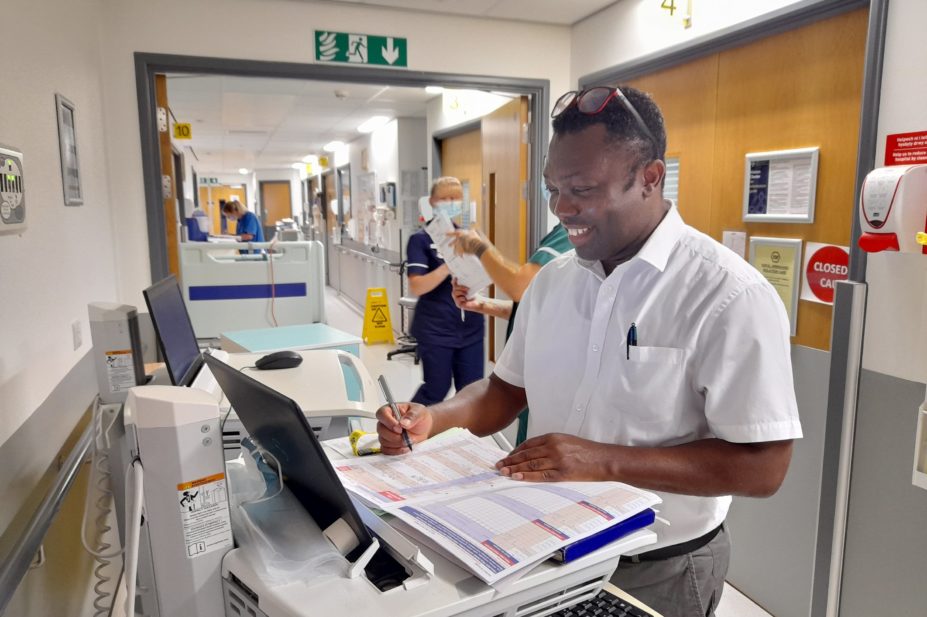
Akwasi Mintah
The management of conditions caused by blood-borne viruses has always fascinated me as a pharmacist, and I was fortunate to complete an HIV/gastroenterology rotation with hepatitis B and C training as part of my postgraduate diploma in 2019.
Since 2019, I have worked as the specialist HIV and gastroenterology pharmacist at Ysbyty Glan Clwyd Hospital in North Wales. As an independent prescribing pharmacist, I provide pharmaceutical care to patients diagnosed with Crohn’s disease and ulcerative colitis, hepatitis B and C, alcoholic hepatitis, HIV and AIDS-related diseases, and auto immune hepatic diseases.
8:30 — start
Today, I have a morning HIV clinic. Although I officially start at 9am, I arrive early to organise myself before the day begins.
I gather my paperwork for the HIV clinic and use the opportunity to glance at my patient list and review any notes I made the previous week for specific patients, including any relevant interactions between medications, advice around medication administration and travelling through different time zones. This helps me structure my consultations.
In North Wales, antiretroviral medications are only supplied to patients from a hospital pharmacy, so I make my way to the dispensary to pick up some medicines needed for the clinic. The support in the dispensary is amazing and the medicines are usually packed and ready by the time I get there.
9:00
Before COVID-19, most of the clinic appointments were attended by an HIV consultant and a pharmacist. Many of the consultations are now conducted virtually by the consultants, and my role is to review and discuss HIV therapy with patients, as well as assess compliance, side effects and possible drug interactions. I only consult with patients face-to-face if needed and supply them with their medication while adhering to personal protective equipment protocols. Otherwise, medications are supplied by the nurses when the patient’s bloods are taken. Most stable HIV patients are seen in clinic biannually and are typically on triple therapy. For example, emtricitabine, tenofovir disoproxil and dolutegravir, or on one tablet containing three medications (e.g. emtricitabine, tenofovir alafenamide and bictegravir).
My first appointment for the day is with a patient I review regularly who was diagnosed with HIV four years ago, and is stable on emtricitabine, tenofovir disoproxil and dolutegravir. I review their bloods and vital signs to make sure there are no anomalies with regards to their antiretroviral treatment.
The patient’s viral load continues to be undetectable with a good CD4 cell count. The patient is happy with their therapy and has no concerns.
I advise the patient to use the short-dated medicines first and inform them that we will do a thorough medication review on their next visit.
Since the genitourinary medicine (GUM) clinic that specialises in sexual health is within the HIV unit, I help with coordinating their supply of medications.
9:20
I have a lull between clinic appointments and use the free time to call Healthcare at Home to clarify a prescription. Healthcare at Home is our pharmacy department that looks after homecare deliveries for high-cost medications.
The call is regarding a prescription for a patient with Crohn’s disease and whether the switch from one biosimilar to another was intentional. I check my notes and discover the patient had experienced stinging at the injection site with the original product, making it harder for them to adhere to therapy. I confirm the switch with the delivery company and complete a yellow card for the incident.
11:00
I continue to clinically screen biologic prescriptions before they are sent to the Healthcare at Home team.
One patient with ulcerative colitis has been prescribed a dose of adalimumab indicated for Crohn’s disease. As the patient’s gastroenterologist is off work this week, I discuss this with the inflammatory bowel disease (IBD) specialist nurse, and we agree to take it to our IBD multidisciplinary team (MDT) meeting that afternoon.
11:30
I receive a call from a pharmacist colleague who is seeking advice about a patient with IBD, who was prescribed a proton pump inhibitor (PPI) for acid reflux but is experiencing hyponatraemia — a side effect of PPIs.
We consider the benefits of using an H2 receptor antagonist, but owing to the significant shortages of ranitidine and countless interactions with cimetidine, we recommend a sodium alginate containing compound instead. The high salt content may also prove beneficial for the hyponatraemia.
12:30
I attend the weekly IBD MDT meeting where I highlight a price reduction for an adalimumab biosimilar approved as first line for IBD. I am still in the process of reviewing the pros and cons of switching stable patients already established on the old biosimilar, but I encourage the MDT to start any new patients on the new formulation.
I also seek clarification on the prescription for the ulcerative colitis patient prescribed the Crohn’s disease dose of adalimumab. The gastroenterologists agree with the plan to change the dose and a consultant amends the prescription. Although I am an independent prescriber, in the presence of other prescribers, I prefer to have them write the prescription so I can clinically check as a pharmacist. This is to reduce the number of medication-related errors as much as possible. Without a prescriber present, I will prescribe if it is within my competence and ask a pharmacist colleague to clinically screen the prescription for me.
13:45
I take my lunch in the pharmacy department with my headphones on listening to Bob Marley while absorbing a John Grisham thriller.
I usually try to disconnect from work during lunchtime but one of the consultant gastroenterologists sends me a WhatsApp message asking how to calculate the dose of intravenous iron for an outpatient. I quickly reply asking for the patient’s weight, current haemoglobin and other relevant bloods in order to calculate the dose.
14:15
I discuss a patient with an HIV/GUM consultant. The patient is HIV positive, admitted with a bowel obstruction and due for surgery. Earlier in the day, a senior house officer sought my advice on how to manage the patient’s antiretroviral medications during the peri-operative period.
The consultant and I agree to monitor the patient’s HIV viral load and wait for the surgeon’s care plan before making a decision about medications.
Interestingly, this patient is a resident in our catchment area and registered with a local GP, but travels 250 miles for their HIV care. I make a note to have a discussion with the patient about the merits of transferring their HIV care to us so that we can keep an eye on their treatment and avoid them having to travel long distances.
In my experience, patients often prefer being seen by the specialist who oversaw their initial HIV care, even if they re-locate. Many patients want a fresh start without the stigma, but it is difficult to provide well-rounded therapy when the patient’s own GP is unaware of their HIV status. For this reason, we try to reassure patients of the benefit of transferring care and leave the decision to them. If individuals choose not to, we endeavour to remain in contact with their HIV care providers until discharge and provide a copy of the discharge letter if needed.
15:30
I send an email to the antibiotic pharmacist, highlighting the results of a root cause analysis for one of my inpatients with Clostridium difficile.
The analysis involves reviewing the patient’s notes over the past six months and recording any antibiotics and PPIs the patient had been taking during that time, including the duration and indication. This helps the antimicrobial team review admitted patients with Clostridium difficile during their MDT meetings.
17:00
I head to the surgical ward to check on the HIV patient with a bowel obstruction. The patient is still in theatre so I request a viral load measurement for the patient and inform the ward doctor that an HIV consultant will review post-surgery.
17:20 — finish
I email the HIV consultants and provide an update on the HIV positive patient undergoing surgery, before I put my headphones on and finish work for the day.
Are you interested in a similar role?
- My role is NHS agenda for change band 7–8a;
- Ideally, you should have a postgraduate clinical diploma and independent prescribing qualifications;
- You must have a friendly attitude, be non-judgemental and able to develop good rapport with patients;
- Be passionate about learning. The antiretroviral and hepatology world is developing and changing rapidly. Keep up to date with guidelines and literature (e.g. British Association for the Study of the Liver, British Society of Gastroenterology, British HIV Association);
- Use every opportunity to attend conferences and workshops if possible. I have a mentor through the Royal Pharmaceutical Society who is available whenever I am confronted with issues and also helps me forge my professional path;
- Learn to use opportunities within the hospital to create a path for yourself, attend ward rounds and use the time spent with different consultants to learn about the conditions being treated.
